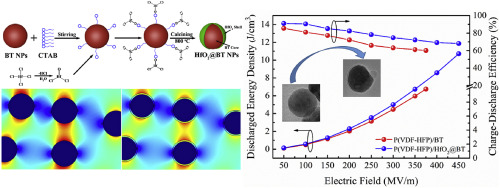当前位置:
X-MOL 学术
›
Compos. Sci. Technol.
›
论文详情
Our official English website, www.x-mol.net, welcomes your
feedback! (Note: you will need to create a separate account there.)
Enhanced energy storage capability of P(VDF-HFP) nanodielectrics by HfO2 passivation layer: Preparation, performance and simulation
Composites Science and Technology ( IF 8.3 ) Pub Date : 2020-03-01 , DOI: 10.1016/j.compscitech.2019.107968 Chao Chen , Yunchuan Xie , Jingjing Liu , Jing Li , Xiaoyong Wei , Zhicheng Zhang
Composites Science and Technology ( IF 8.3 ) Pub Date : 2020-03-01 , DOI: 10.1016/j.compscitech.2019.107968 Chao Chen , Yunchuan Xie , Jingjing Liu , Jing Li , Xiaoyong Wei , Zhicheng Zhang

|
Abstract Flexible dielectric nanocomposites have shown great potential for electrostatic capacitors due to their excellent energy storage properties. In an effort to eliminate the disadvantages induced by the interfacial polarization of two different components in the nanocomposite, in this work, HfO2@BaTiO3 nanoparticles (HfO2@BT NPs) with core-shell structure were synthesized and used to fabricate poly(vinylidene fluoride-co-hexafluoropropylene) (P(VDF-HFP))/HfO2@BT nanocomposite films via solution casting method. The passivation HfO2 layer with high resistivity and moderate dielectric permittivity could act as a buffering barrier and alleviate the dielectric mismatch between the BT nanoparticles (BT NPs) and P(VDF-HFP) matrix. The breakdown strength (Eb) and discharged energy density (Ue) of P(VDF-HFP)/HfO2@BT nanocomposites have been substantially enhanced. The nanocomposite filled with 1 wt% HfO2@BT presents a maximum Ue of 10.7 J/cm3 at 450 MV/m, which is 36% and 59% higher than that of the pristine P(VDF-HFP) and nanocomposite filled with the same BT NPs, respectively. Meanwhile, P(VDF-HFP)/HfO2@BT nanocomposites show a charge-discharge efficiency of 72%, which is superior to most of the reported values. The possible mechanism of HfO2 layer on above performance enhancements is proposed based on both experimental analysis and finite element simulation. This work demonstrates that utilizing dielectric fillers with passivation layer might be an effective way to improve the energy storage performance of the flexible dielectric nanodielectrics.
中文翻译:

HfO2 钝化层增强 P(VDF-HFP) 纳米电介质的储能能力:制备、性能和模拟
摘要 柔性介电纳米复合材料由于其优异的储能性能,在静电电容器方面显示出巨大的潜力。为了消除纳米复合材料中两种不同组分的界面极化引起的缺点,在这项工作中,合成了具有核壳结构的 HfO2@BaTiO3 纳米颗粒 (HfO2@BT NPs) 并用于制造聚偏二氟乙烯-共六氟丙烯) (P(VDF-HFP))/HfO2@BT 纳米复合薄膜通过溶液浇铸方法。具有高电阻率和中等介电常数的钝化 HfO2 层可以作为缓冲屏障,减轻 BT 纳米粒子 (BT NPs) 和 P(VDF-HFP) 基质之间的介电不匹配。P(VDF-HFP)/HfO2@BT纳米复合材料的击穿强度(Eb)和放电能量密度(Ue)得到了显着提高。填充有 1 wt% HfO2@BT 的纳米复合材料在 450 MV/m 下的最大 Ue 为 10.7 J/cm3,比原始 P(VDF-HFP) 和填充相同材料的纳米复合材料高 36% 和 59%。分别为 BT NP。同时,P(VDF-HFP)/HfO2@BT 纳米复合材料的充放电效率为 72%,优于大多数报道的值。基于实验分析和有限元模拟,提出了 HfO2 层对上述性能增强的可能机制。这项工作表明,利用具有钝化层的介电填料可能是提高柔性介电纳米电介质储能性能的有效方法。填充 1 wt% HfO2@BT 的纳米复合材料在 450 MV/m 下的最大 Ue 为 10.7 J/cm3,比原始 P(VDF-HFP) 和填充相同材料的纳米复合材料高 36% 和 59%。分别为 BT NP。同时,P(VDF-HFP)/HfO2@BT 纳米复合材料的充放电效率为 72%,优于大多数报道的值。基于实验分析和有限元模拟,提出了 HfO2 层对上述性能增强的可能机制。这项工作表明,利用具有钝化层的介电填料可能是提高柔性介电纳米电介质储能性能的有效方法。填充有 1 wt% HfO2@BT 的纳米复合材料在 450 MV/m 下的最大 Ue 为 10.7 J/cm3,比原始 P(VDF-HFP) 和填充相同材料的纳米复合材料高 36% 和 59%。分别为 BT NP。同时,P(VDF-HFP)/HfO2@BT 纳米复合材料的充放电效率为 72%,优于大多数报道的值。基于实验分析和有限元模拟,提出了 HfO2 层对上述性能增强的可能机制。这项工作表明,利用具有钝化层的介电填料可能是提高柔性介电纳米电介质储能性能的有效方法。分别比原始 P(VDF-HFP) 和填充相同 BT NP 的纳米复合材料高 36% 和 59%。同时,P(VDF-HFP)/HfO2@BT 纳米复合材料的充放电效率为 72%,优于大多数报道的值。基于实验分析和有限元模拟,提出了 HfO2 层对上述性能增强的可能机制。这项工作表明,利用具有钝化层的介电填料可能是提高柔性介电纳米电介质储能性能的有效方法。分别比原始 P(VDF-HFP) 和填充相同 BT NP 的纳米复合材料高 36% 和 59%。同时,P(VDF-HFP)/HfO2@BT 纳米复合材料的充放电效率为 72%,优于大多数报道的值。基于实验分析和有限元模拟,提出了 HfO2 层对上述性能增强的可能机制。这项工作表明,利用具有钝化层的介电填料可能是提高柔性介电纳米电介质储能性能的有效方法。基于实验分析和有限元模拟,提出了 HfO2 层对上述性能增强的可能机制。这项工作表明,利用具有钝化层的介电填料可能是提高柔性介电纳米电介质储能性能的有效方法。基于实验分析和有限元模拟,提出了 HfO2 层对上述性能增强的可能机制。这项工作表明,利用具有钝化层的介电填料可能是提高柔性介电纳米电介质储能性能的有效方法。
更新日期:2020-03-01
中文翻译:

HfO2 钝化层增强 P(VDF-HFP) 纳米电介质的储能能力:制备、性能和模拟
摘要 柔性介电纳米复合材料由于其优异的储能性能,在静电电容器方面显示出巨大的潜力。为了消除纳米复合材料中两种不同组分的界面极化引起的缺点,在这项工作中,合成了具有核壳结构的 HfO2@BaTiO3 纳米颗粒 (HfO2@BT NPs) 并用于制造聚偏二氟乙烯-共六氟丙烯) (P(VDF-HFP))/HfO2@BT 纳米复合薄膜通过溶液浇铸方法。具有高电阻率和中等介电常数的钝化 HfO2 层可以作为缓冲屏障,减轻 BT 纳米粒子 (BT NPs) 和 P(VDF-HFP) 基质之间的介电不匹配。P(VDF-HFP)/HfO2@BT纳米复合材料的击穿强度(Eb)和放电能量密度(Ue)得到了显着提高。填充有 1 wt% HfO2@BT 的纳米复合材料在 450 MV/m 下的最大 Ue 为 10.7 J/cm3,比原始 P(VDF-HFP) 和填充相同材料的纳米复合材料高 36% 和 59%。分别为 BT NP。同时,P(VDF-HFP)/HfO2@BT 纳米复合材料的充放电效率为 72%,优于大多数报道的值。基于实验分析和有限元模拟,提出了 HfO2 层对上述性能增强的可能机制。这项工作表明,利用具有钝化层的介电填料可能是提高柔性介电纳米电介质储能性能的有效方法。填充 1 wt% HfO2@BT 的纳米复合材料在 450 MV/m 下的最大 Ue 为 10.7 J/cm3,比原始 P(VDF-HFP) 和填充相同材料的纳米复合材料高 36% 和 59%。分别为 BT NP。同时,P(VDF-HFP)/HfO2@BT 纳米复合材料的充放电效率为 72%,优于大多数报道的值。基于实验分析和有限元模拟,提出了 HfO2 层对上述性能增强的可能机制。这项工作表明,利用具有钝化层的介电填料可能是提高柔性介电纳米电介质储能性能的有效方法。填充有 1 wt% HfO2@BT 的纳米复合材料在 450 MV/m 下的最大 Ue 为 10.7 J/cm3,比原始 P(VDF-HFP) 和填充相同材料的纳米复合材料高 36% 和 59%。分别为 BT NP。同时,P(VDF-HFP)/HfO2@BT 纳米复合材料的充放电效率为 72%,优于大多数报道的值。基于实验分析和有限元模拟,提出了 HfO2 层对上述性能增强的可能机制。这项工作表明,利用具有钝化层的介电填料可能是提高柔性介电纳米电介质储能性能的有效方法。分别比原始 P(VDF-HFP) 和填充相同 BT NP 的纳米复合材料高 36% 和 59%。同时,P(VDF-HFP)/HfO2@BT 纳米复合材料的充放电效率为 72%,优于大多数报道的值。基于实验分析和有限元模拟,提出了 HfO2 层对上述性能增强的可能机制。这项工作表明,利用具有钝化层的介电填料可能是提高柔性介电纳米电介质储能性能的有效方法。分别比原始 P(VDF-HFP) 和填充相同 BT NP 的纳米复合材料高 36% 和 59%。同时,P(VDF-HFP)/HfO2@BT 纳米复合材料的充放电效率为 72%,优于大多数报道的值。基于实验分析和有限元模拟,提出了 HfO2 层对上述性能增强的可能机制。这项工作表明,利用具有钝化层的介电填料可能是提高柔性介电纳米电介质储能性能的有效方法。基于实验分析和有限元模拟,提出了 HfO2 层对上述性能增强的可能机制。这项工作表明,利用具有钝化层的介电填料可能是提高柔性介电纳米电介质储能性能的有效方法。基于实验分析和有限元模拟,提出了 HfO2 层对上述性能增强的可能机制。这项工作表明,利用具有钝化层的介电填料可能是提高柔性介电纳米电介质储能性能的有效方法。











































 京公网安备 11010802027423号
京公网安备 11010802027423号